Bran Castle is a national monument and landmark in Romania. The castle is on the border between Transylvania and Wallachia, on a high rock above the river valley. The Teutonic Knights built the castle in the 13th century as a defensive stronghold, which later became a royal residence. The castle attracts thousands of tourists every year as one of the best things to do in Transylvania, who come to see the beautiful architecture and learn about its interesting history. We hope you find this guide to visiting Bran Castle helpful in making your travel plans and understanding more about this castle’s fascinating history!
Be sure to check out some of the other, lesser-known (yet equally as beautiful) castles of Transylvania during your stay!
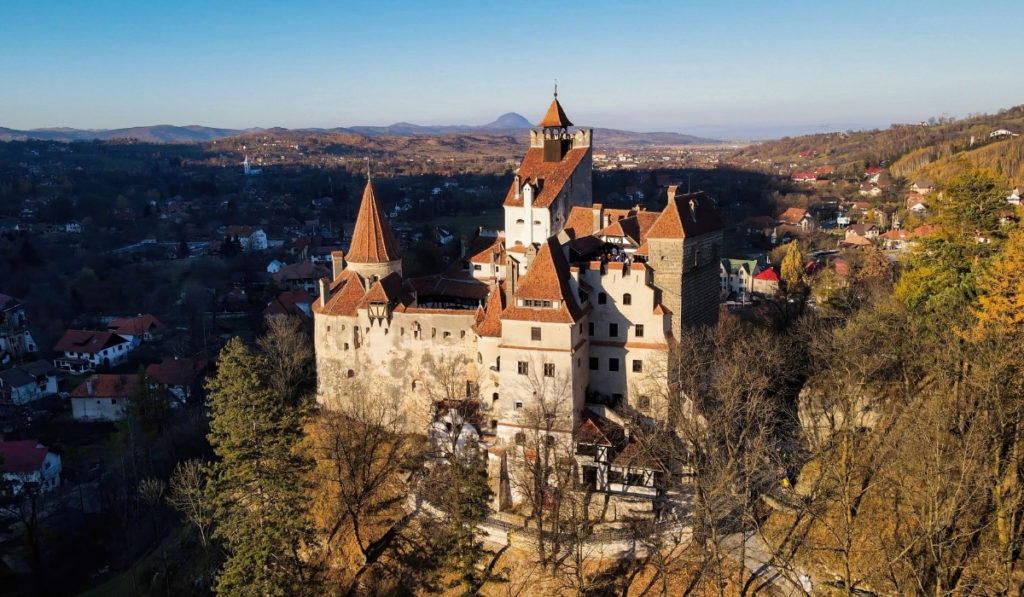
Where is Bran Castle?
Bran Castle, also known as Dracula’s Castle or Castelul Bran, is located in Romania. The castle is on the border of Transylvania and Wallachia, about 30 kilometers south of Brasov in the village of Bran.
Bran village is a small, traditional Romanian village located in the heart of Transylvania. Beautiful mountains and forests surround the village, which is home to a friendly community of locals who are proud of their heritage and culture. Bran village is the perfect place to escape the hustle and bustle of city life, and to enjoy some peace and quiet in nature. There are plenty of things to see and do in the area, including hiking, horse riding, and of course, experience Castelul Bran.
The village itself has grown quite kitschy and touristic over the years, but it still has a certain charm to it. Despite the wooden stands selling Dracula memorabilia, cheap keychains, and other mass-produced souvenirs, it’s a flavor that is distinctly Romanian.
How to Get to Bran Castle
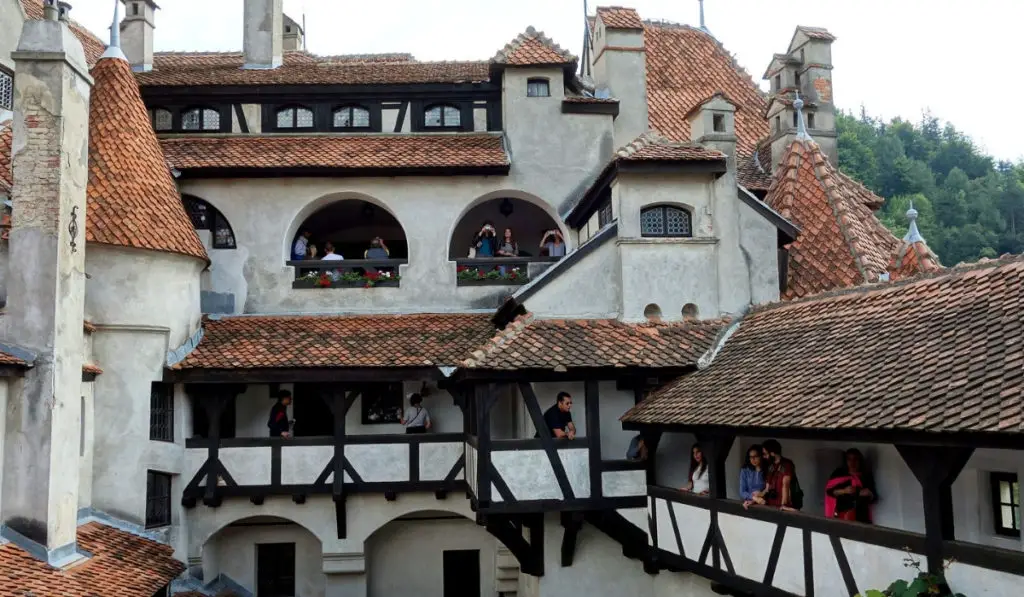
Brasov to Bran Castle
Bran Castle is an easy day trip from Brasov given its close proximity.
There are a few ways to get to Bran Castle from Brasov. You can either take a bus, which takes about an hour, or you can drive, which takes about half an hour. If you’re driving, you’ll need to take the E60 towards Sibiu and then turn onto the DN73. Once you’re on the DN73, follow it until you see signs for Castelul Bran. When you get to the castle, there is plenty of parking available.
Bucharest to Bran Castle
There are a few ways to get to Bran Castle from Bucharest. You can either take the train, which takes about three hours, or you can drive, which takes around two and a half hours. If you’re driving, you’ll need to take the E60 towards Brasov. Once you get to Brasov, follow the signs for Bran. The castle is located just outside of town.
If you’re taking the train, there are a few different routes you can take. The fastest way is to take the Intercity train from Bucharest North Railway Station to Brasov. This train makes a few stops along the way, but it’s still the quickest option. Another option is to take a regional train from Bucharest Nord to Predeal. From there, you can take a local train to Brasov. This route takes a bit longer, but it’s cheaper.
Sibiu to Bran Castle
The best way to get to Bran Castle from Sibiu is by car. It takes about two hours to drive there, and the journey is very scenic. You can also take a bus or train, but the schedule can be a bit unpredictable. If you’re feeling adventurous, you could even try hitchhiking! Whichever way you choose to travel, make sure you give yourself plenty of time to explore the castle once you arrive. It’s definitely worth the trip!
Bran Castle Frequently Asked Questions
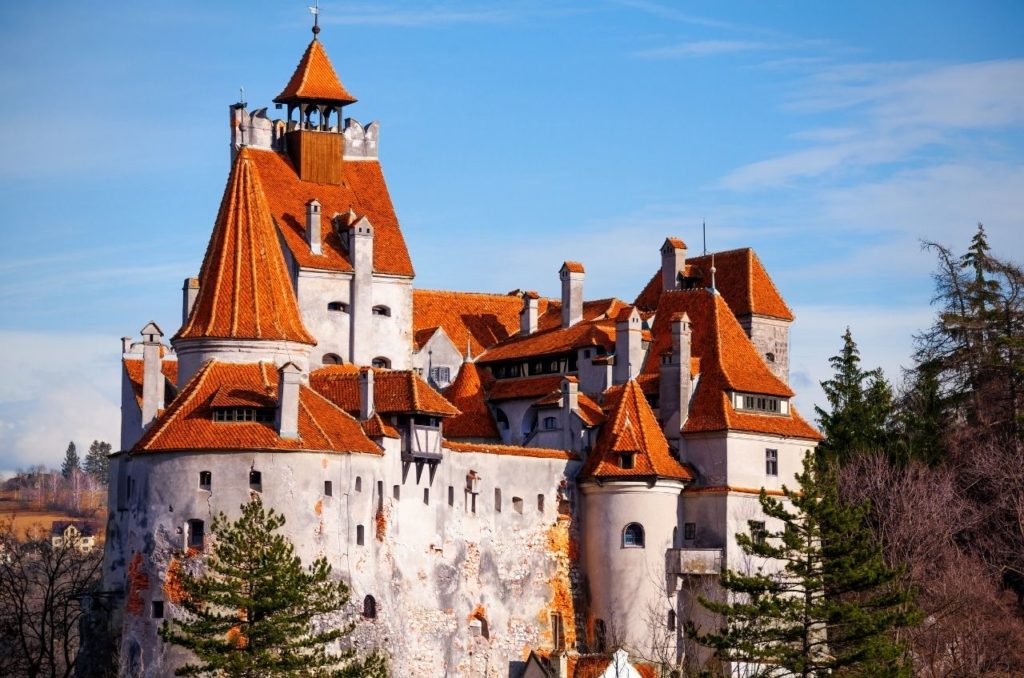
Is Bran Castle also Dracula’s Castle?
The legend of Bran Castle being Dracula’s Castle spurs from Bram Stoker’s novel, Dracula. The title character was a Transylvanian Count and legendary vampire who lived in a castle situated high on a rocky cliff overlooking a river in the Carpathian Mountains. Though the Dracula legend holds no water and is entirely myth, the air of mystery that surrounds the association between the infamous character and the real Bran Castle still draws tourists in by the thousands.
Many believe that the character of Count Dracula is based on Vlad Tepes, aka Vlad the Impaler, aka Vlad Dracul. Vlad Tepes was the Prince of Wallachia. It is assumed that, because Castle Bran is the only castle in the region that vaguely resembles Bram Stoker’s description, that it must be the same.
However, Bram Stoker never actually visited Romania. People say that Bram Stoker came up with his description of Dracula’s Castle based on a drawing from a book about Transylvania by Charles Boner, a prominent British writer of the time.
The bloodthirsty nature of Count Dracula coupled with the bloodthirsty reputation of Vlad Tepes certainly furthers the likeness of the two. However, the infamous character was not based on Vlad the Impaler.
Vlad the Impaler’s associations with Bran Castle exist, but don’t hold much significance. Vlad was the Prince of Wallachia, and the nearest passage from Brasov to Wallachia was via Bran. However, there is no documentation that supports the rumor that Vlad captured Bran Castle.
Documents do, however, support the fact that Vlad III Dracula was a prisoner in Bran Castle for two months. This happened in late 1462, when Matthias Corvin captured Vlad Tepes.
Today, the associations of Bran Castle being synonymous with Dracula’s Castle are mostly marketing tactics by the Romanian tourism board. And it was a largely successful campaign! Bran Castle is the destination most visited by tourists throughout all of Romania. And even though it has nothing to do with vampires, it’s still called Dracula’s Castle, thanks mostly in part to Bram Stoker’s novel.
Can You Stay in Bran Castle?
The simple answer is no, you can’t stay in Bran Castle overnight. However, there are a few ways that you can get pretty close to the experience.
You can rent out an apartment in the village of Bran or stay in one of the many bed and breakfasts located nearby. There are also a few hotels located within a reasonable driving distance from the castle.
So while you may not be able to sleep in Dracula’s actual bedroom, you can still enjoy all that Bran Castle has to offer by staying in one of these accommodations.
Does Bran Castle Have Food?
Yes! There is a restaurant on-site at Bran Castle, Casa de Ceai, aka the Tea House. Of course, considering the fact that it’s a major tourist attraction, you would expect prices here to be much more expensive than at your standard restaurant in Bran or Brasov. However, the prices are not too steep (except for breakfast – breakfast prices seem very high for Romania at 42 lei per plate!). They serve plenty of traditional Romanian cuisine.
Reservations are recommended during the summer months when the castle receives the most visitors.
History of Bran Castle
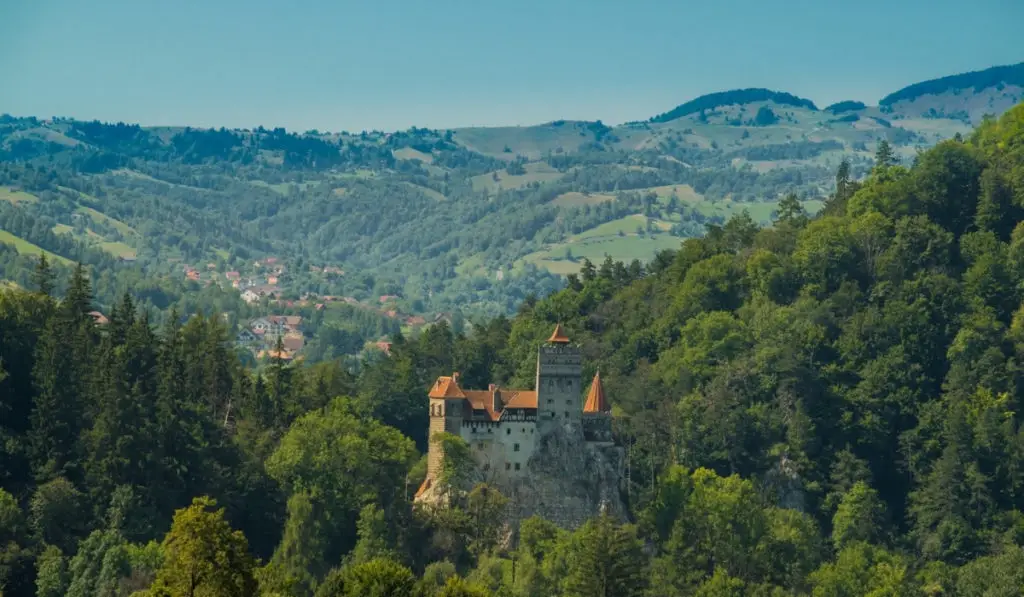
The history of Dracula’s Castle dates all the way back to 1211, when the Teutonic Knights first built it, and spans up until the present day. Through multiple transfers of ownership, sieges, destruction from natural events, ongoing restorations, a somewhat complicated relationship with its neighboring towns, to its present day tourism, Bran Castle has quite the extensive history.
13th Century
The Teutonic Knights built a fortress in Bran in 1211 to defend the border of Transylvania. They were eventually forced out of the area in 1226.
14th Century
King Louis the Great granted the Brasov people the right to build a castle. The king also urged the Saxons who inhabited the area to participate.
Finally, construction of the castle was completed on a dramatic cliff. Upon its completion, it was used as a customs center as well as that of a fortress. The castle held 3% of goods entering and exiting Transylvania.
In its role as a stronghold, Bran Castle was meant to deter the Ottoman Empire from expanding into the boundaries of Transylvania.
Soldiers and mercenaries lived at the castle, along with the Lord of the castle. The lord was elected by the King and was generally someone of Saxon origin. In the late 1600s, the lord also held the status of Vice-Voivode of Transylvania.
15th Century
Used to gain loyalty, Sigismund of Luxembourg gave the castle to Prince Mircea, who was the Elder of Wallachia as a place of refuge in the event that the Ottomans invaded.
Following Mircea’s death in 1419, Sigismund reclaimed the castle and gave it to the Princes in Transylvania.
In 1441, the Ottomans finally invaded Transylvania, but John Hunyadi, the Prince of Transylvania, had them defeated.
In the mid-1400s, the Princes of Transylvania instructed Vlad Tepes (Vlad the Impaler) to handle the Ottoman problem at the border. During this time, he was allied with Bran and Brasov. However, only a few years later, during his second reign, Vlad Tepes’ army attacked Brasov in order to settle a tax dispute between the Saxons and the Wallachian Voivode. He murdered hundreds of Transylvanian Saxons and burned the suburbs of Brasov to the ground. This spurred the rumors of Vlad Tepes’ ruthlessness and torture for centuries to come.
In 1462, Matthias Corvin captured Vlad the Impaler and held him prisoner in Bran Castle for two months.
In the last years of the century, Saxons purchased Bran Castle.
16th & 17th Centuries
During the previous century, Transylvania became part of the Habsburg Empire. In the middle of the century, George II Rackoczi bought the castle.
18th & 19th Centuries
Renovations from previous attacks on the castle were completed in the 1700s.
By the mid 19th century, Bran Castle lost all military and political significance when the border of Transylvania and Wallachia was moved.
More renovations ensued following the damages from the 1848 Revolution.
Eventually, the castle was transferred to the region’s forestry. For 30 years its only inhabitants were forest workers and woodsmen.
20th & 21st Centuries
In 1918, Transylvania became part of Romania after the first world war.
In 1920, the Brasov residents unanimously decided to bestow the Castelul Bran to Queen Maria of Romania, who subsequently fell in love with it. She had it restored to imperial glory and established as the residence for the royal family. Following Maria’s death, Princess Ileana inherited the castle.
Eventually, following the rise of the communist regime, Ileana left Romania and moved to the United States.
In the 1950s, Bran Castle became a museum. It subsequently underwent further renovations and restorations in the 1980s before reopening to tourists as a museum once again in the 1990s.
In 2006, after many court proceedings, the castle was rightfully returned to the heirs of Princess Ileana.
How Old is Bran Castle?
The earliest record of the castle dates back to 1211. However, some say that the Teutonic Knights built the castle even earlier, in the 11th century. Today, the castle is a popular tourist destination. It attracts visitors from all over the world who come to see its unique architecture and to learn about its history.
Visiting Bran Castle
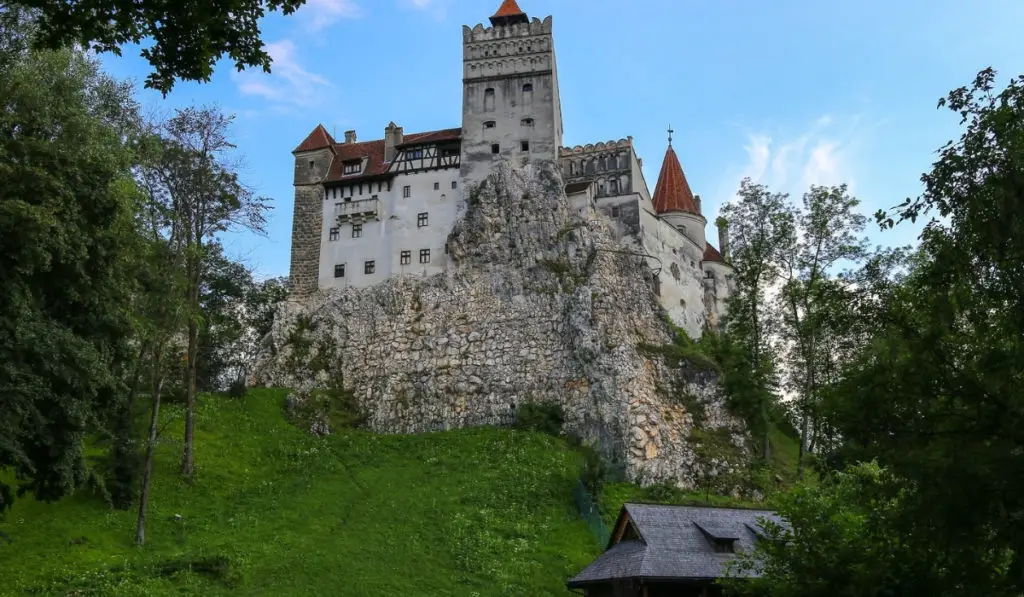
Bran Castle Hours
9:00 AM to 6:00 PM Tuesday through Sunday
12:00 PM to 6:00 PM Monday
Bran Castle Admission Prices
Adults: 45 lei ($9 USD)
Seniors 65+: 35 lei ($7 USD)
Students: 25 lei ($5 USD)
Children: 10 lei ($2 USD)
Free for children under 7 and guests with disabilities.
Bran Castle Exterior
The first thing that you’ll notice is the imposing structure of the castle itself. Perched atop a hill in Transylvania, it’s certainly an impressive sight. But there’s more to Bran Castle than just its looks. Inside, you’ll find a fascinating museum that tells the history of the castle and its occupants.
The castle is situated on a rocky hilltop in the Transylvanian countryside. Forests surround the castle on all sides, and there are often misty mornings in the area. The castle itself is quite large, and it has a lot of towers and turrets. It’s definitely a place that looks like it could be haunted!
The exterior of the castle is mostly grey stone, and it’s in pretty good condition considering its age. There are some areas that are falling apart, but overall it looks like it’s been well-maintained.
The atmosphere around the castle is very eerie and foreboding. It feels like something bad could happen at any moment!
Be sure to explore the grounds as well, where you’ll find a beautiful garden and stunning views of the surrounding countryside. And if you’re feeling brave, take a walk through the creepy dungeons! Just don’t forget to watch out for vampires…
Bran Castle Interior
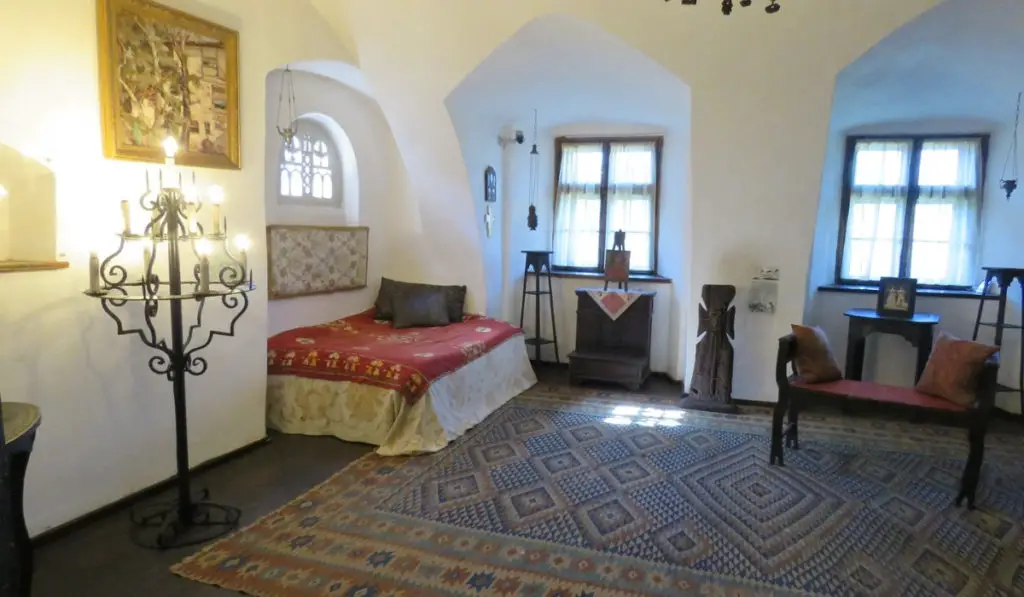
The castle’s interior is quite interesting, and it gives a good glimpse into the past. The decoration is not very ornate, though it is clear that a lot of care went into making the castle look its best. However, the castle is in need of some repair, as many of the tapestries are falling apart and there is water damage in some of the rooms. Despite this, the castle still has an amazing ambiance and it is easy to imagine what life was like for those who lived here centuries ago.
It is a mix of traditional Romanian and Gothic elements. Tapestries, carpets, and furniture that date back to the 14th century decorate the rooms. The ambiance of the castle is very cozy and inviting. Despite its age, the castle is very well-preserved and it gives off an air of mystery.
Visiting Bran Castle is like stepping into a fairytale. It is truly a unique place that should not be missed if you are ever in Romania! Whether you are a fan of castles or not, Bran Castle will definitely leave you enchanted.
Bran Castle Facts
The Castle Water Well
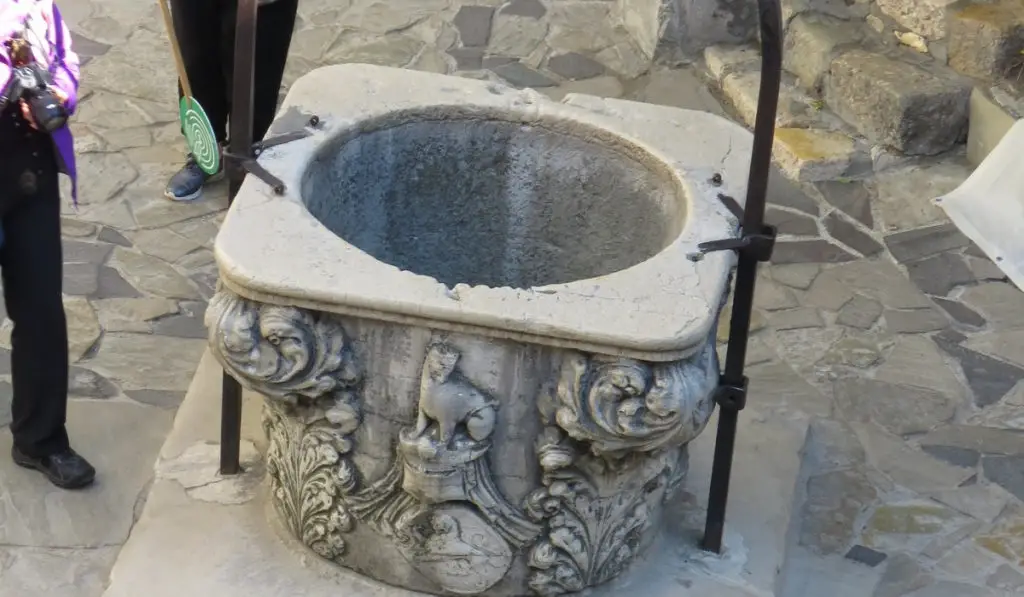
Water wells were extremely important to medieval castles for a number of reasons. Firstly, they provided a source of fresh water for the residents of the castle. This was especially important in times of siege, when the castle’s water supply might be cut off.
Second, water wells could be used as a means of defense against attackers. If an attacker tried to poison the castle’s water supply, the well could be used to flush out the contaminated water.
Finally, water wells could also be used as a way to dispose of waste and sewage. This was particularly important in times of war, when sanitation conditions inside the castle might deteriorate rapidly. without access to clean water, medieval castles would have been incredibly unpleasant places to live in!
The well at Bran Castle is a little unique. Given the castle’s location at the top of a cliff, you can imagine the difficulties that the builders of the time faced when constructing the well. They had to dig all the way down through solid rock in order to access water.
Immediately above water level lies a secret chamber room, a place to hide in the event the castle was sieged by enemies. The purpose of the room was to protect inhabitants and the castle’s treasury.
When Queen Marie inherited the castle in 1920, she expanded the room with an additional 30 foot long tunnel and furnished the old well with an elevator. This was all done so that Queen Marie could easily go between the castle and the park without having to make the strenuous climb.
Bran Castle has a Secret Passage
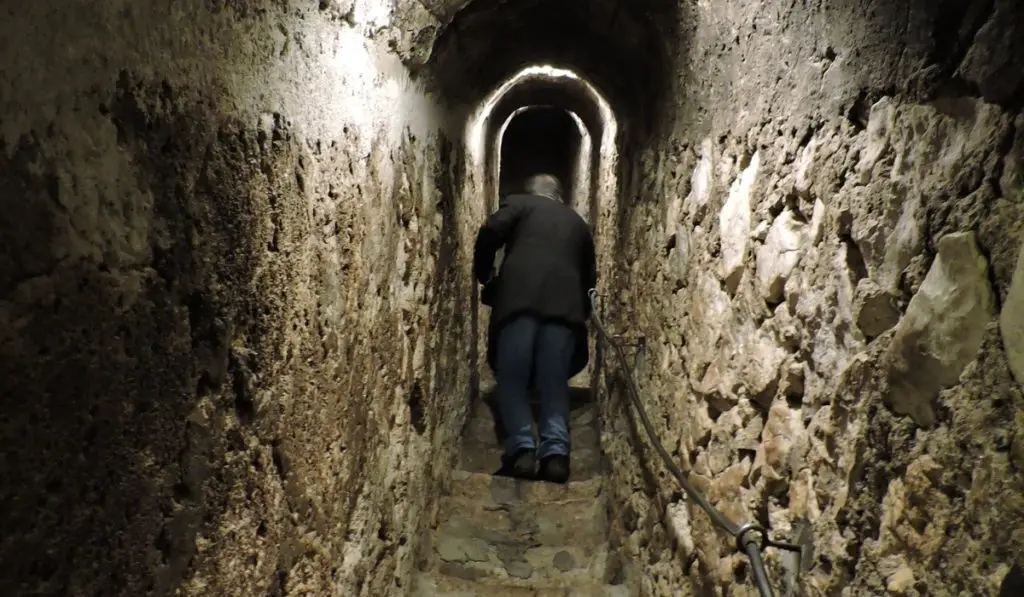
The Bran Castle secret passage is a hidden staircase that leads from the first floor to the third floor of the castle. The passage is also said to be cursed, and anyone who tries to use it will be cursed as well. The only way to break the curse is to find the key that unlocks the door at the top of the staircase.
If you’re looking for a thrill, then visiting Bran Castle and trying to find the secret passage is definitely for you! Just be sure to bring a friend with you, in case you get lost! And if you do find the key, don’t forget to let us know!
Queen Marie’s Heart Lives at Bran Castle
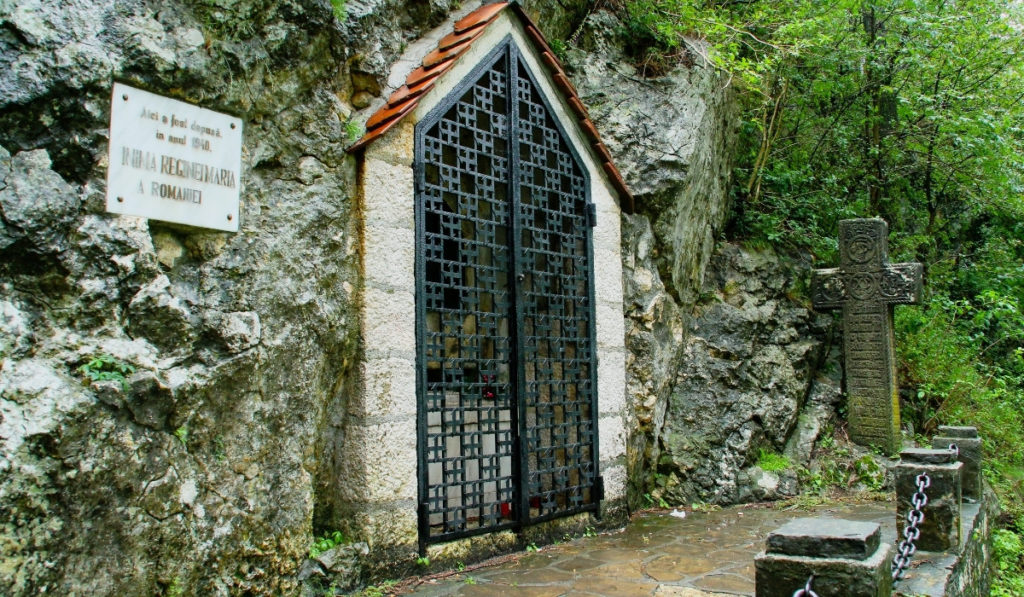
Did you know that there’s a real human heart hidden inside Bran Castle? It belongs to Queen Marie of Romania, who died in 1920. Her heart was removed from her body and placed in a special gold-and-silver case per her request, after she fell in love with the castle. The urn is shaped like a castle, and it’s kept at Bran Castle in Romania.
If you’re visiting Bran Castle, be sure to take a peek at Queen Marie’s heart. It’s not every day that you get to see a real human heart – though, you can’t actually see through the urn! Who knows, maybe Queen Marie’s heart will give you some extra luck on your travels.
Bran Castle Torture Chamber
The castle was home to many torture devices, which were used to extract information from prisoners. Some of the most popular devices included the rack, the Iron Maiden, and the Judas Cradle. The castle also had a special room known as the “Bloody Tower”, where prisoners were often tortured and killed.
Bran castle was also known for its dark secrets. It was said that some of the rooms in the castle were so full of blood, that it seeped through the walls. There are also reports of ghosts haunting the castle, which is no surprise considering its gruesome history.
Bran Castle Events
There are a number of events held at Bran Castle throughout the year for special occasions. Some are recurring, such as the epic Halloween party and Jazz at Bran Castle, while some are temporary and only held occasionally. Check the events section of Bran Castle’s website for more information.
Halloween Events: Usually in the days leading up to and including Halloween, October 31
Jazz at Bran Castle: Usually held in August
Special Exhibitions: The Making of Bram Stoker’s Dracula
Bran Castle Tours
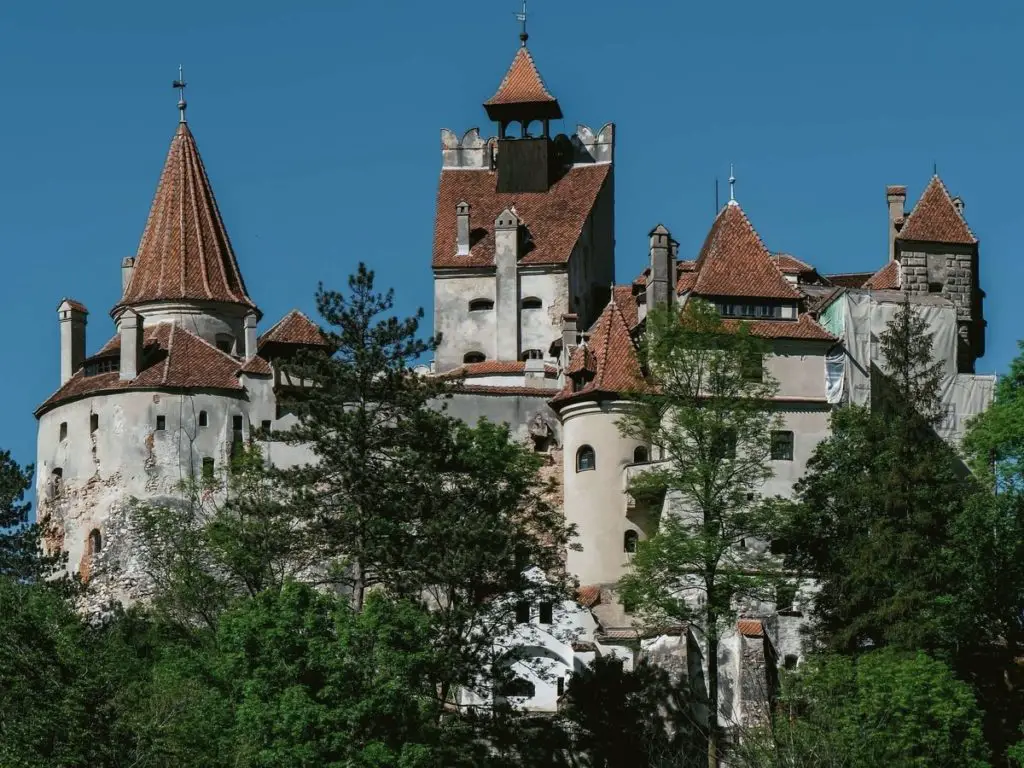
There are a ton of Bran Castle tours (guided) available throughout Transylvania. We’ve listed some of the most popular Bran Castle tours below.
Bran Castle, Peles Castle, Old Town Brasov Tour
Description: Visit two of Romania’s most famed castles, Bran Castle and Peles Castle, before heading into the Old Town of Brasov to do some independent sightseeing on this guided tour.
Departs From: Bucharest
Length: 12 Hours
Price: From $35 USD per person
What to Bring: Water and snacks, cash for gratuities and castle entrance fees.
Helpful Information: Entrance tickets to both castles are not included in the price of the tour. Children under the age of 4 are not permitted.
Dracula’s Castle and Birthplace Tour
Description: Visit Dracula’s Castle in Bran and Vlad Tepes’ birthplace in Sighisoara all in one day.
Departs From: Cluj-Napoca
Length: 15 Hours
Price: From $165 USD per person
What to Bring: Water and snacks, cash for gratuities, sun hat and sunglasses.
Helpful Information: Not suitable for people with mobility issues.
Bear Sanctuary, Bran Castle, and Rasnov Fortress Tour
Description: See a real Romanian brown bear rehabilitation sanctuary, explore the grounds and interior of Bran Castle, and explore Rasnov Fortress on this day trip from Brasov.
Departs From: Brasov
Length: 7.5 Hours
Price: From $90 USD per person
What to Bring: Water and snacks, cash for gratuities, sun hat and sunglasses.
Helpful Information: Not suitable for people with mobility issues.
We hope you enjoy your visit to Dracula’s Castle, one of the top things to do in Romania!

